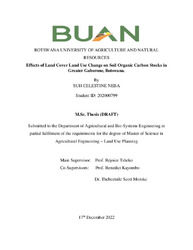| dc.description.abstract | Changes in Land cover land use (LCLU) have long been considered to be among the many factors responsible for the physical and chemical degradation of the soil. Soils are potentially a viable sink for atmospheric carbon and could contribute to mitigating global climate change. Soil Organic Carbon (SOC) content exhibits considerable spatial variability both horizontally according to land use and vertically within the soil profile. Land cover land (LCLU) use is one of the most important determinants of SOC stock. The focus of this study was to investigate the effects of LCLU change on SOC stock in the Greater Gaborone region of Botswana between 1988 and 2022. The study employed Remote Sensing and GIS tools for analyzing LCLU change in the study area between 1988 and 2022. Landsat images of 1988 and 2002 and Sentinel-2A images of 2022 were used to study the changes in the LCLU of the study area. Image classification was performed using a Supervised classification approach based on a Maximum Likelihood classifier. Six major LCLU types (water body, tree cover, cropland, shrubland, bare land, and built-up) were identified in the study area. Post Classification Comparison (PCC) approach was used to detect LCLU change and also quantify the magnitude of the change. Shrubland class was found to be the dominant LCLU type in the study area during the study period. In the study period, a significant LCLU gain was observed in the built-up class (75.12 km2 (310.16%)), while significant losses were observed in shrub land (24.16 km2 (5.67%)) and tree cover (33.32 km2 (25.69%)) classes. The Walkley and Black method (1934), core method (Blake and Hartge, 1986), Bouyoucos hydrometric methods (van Reeuwijk, 2002; Petrenko & Berezhnyak, 2008), and pH meter (Okalebo et al., 2002) were used to determine SOC content, bulk density, soil texture, and pH, respectively. The current SOC stock in the study area was estimated to be 4.36 MtC, with tree cover accounting for 1.13 MtC (25.87%), shrubland 2.83 MtC (64.86%), cropland 0.14 MtC (3.24%), built-up 0.22 MtC (5.11%), and bare land 0.04 MtC (0.92%). The higher SOC in the build-up compared to bare land was due to its higher clay and silt content. This study found that LCLU changes were responsible for variations in SOC content, soil bulk density, pH, and texture in the study area. Also, it was found that soil under tree cover stored more SOC compared to the other LCLU types due to its low bulk density, low pH, and high silt and clay contents. Furthermore, soil bulk density, pH, and sand fraction negatively correlated with SOC content, while silt and clay showed a positive correlation. In addition, the study found that converting from tree cover to xiii shrubland or from shrubland to either cropland, built-up or bare land resulted in the loss of SOC from the study area. Analysis of future LCLU changes between 2022 and 2040, modelled using the CA-ANN model in MOLUSCE, showed that the tree cover will lose 17.4 km2 of its area coverage by 2040, implying more SOC will be lost from the study area. SOC loss is detrimental to the environment as it increases the concentrations of greenhouse gas CO2 in the atmosphere, which contributes to climate change. Therefore, appropriate land management interventions that increase SOC stock and reduce carbon emissions should be designed and implemented in the study area. | en_US |

